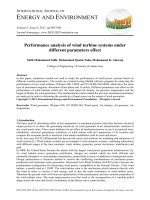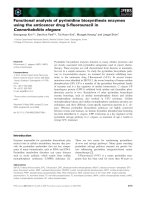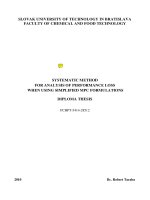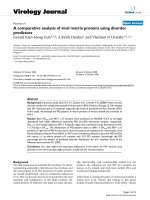Inverse analysis of dental implant systems using finite element method
Bạn đang xem bản rút gọn của tài liệu. Xem và tải ngay bản đầy đủ của tài liệu tại đây (1.62 MB, 156 trang )
INVERSE ANALYSIS OF DENTAL IMPLANT SYSTEMS
USING FINITE ELEMENT METHOD
DENG BIN
(BDS, XJTU)
A THESIS SUBMITTED
FOR THE DEGREE OF DOCTOR OF PHILOSOPHY
DEPARTMENT OF RESTORATIVE DENTISTRY
NATIONAL UNIVERSITY OF SINGAPORE
2006
Acknowledgements
First and foremost, I would like to express my profound and sincere gratitude to my
supervisors, Associate Professor Keson Tan Beng Choon and Professor Liu Gui-Rong,
for getting me into the world of biomechanics and for their guidance, patience and
invaluable advice over the past years. I have learnt tremendously from their experience
and expertise, and am truly indebted to them.
I would also like to thank Professor Nicholls Jack I and Professor Han Xu for their
enthusiasm and great efforts to explain things clearly and simply.
In addition, I would like to express my appreciation to all the members at Dean’s
office, Department of Restorative Dentistry and Centre for Advanced Computations in
Engineering Science (ACES) for their support and assistance in many different ways.
Special thanks are conveyed to Mr. Martin Vogt of Institut Straumann AG and Mr.
Jameson Wu of Nobel Biocare AB for providing the mechanical drawings.
Last but not least, I would like to dedicate this dissertation to my parents, my parents-
in-law and my wife Dr. Yang Guiyu for their continual support and encouragement.
i
Table of Contents
Acknowledgements i
Table of Contents ii
Summary v
Acronyms viii
Notations ix
List of Figures x
List of Tables xiii
Chapter 1 Introduction and Literature Review 1
1.1 Introduction 1
1.2 Literature review 5
1.2.1 Structural static analysis 5
1.2.1.1 Biomechanical response of abutment-implant screw joint interface 6
1.2.1.2 Biomechanical response of dental implant-bone interface 12
1.2.2 Dynamic response analysis 35
1.2.3 Inverse analysis 38
1.3 Objectives and Scope 39
Chapter 2 FEA of Dental Angulated Abutment Implant-Bone Systems 42
2.1 Introduction 42
2.2 Methodology 43
2.2.1 3-D geometric modeling 44
2.2.2 Material properties 48
2.2.3 FEA mesh 48
2.2.4 Loading and boundary conditions 50
2.3 Results 52
2.3.1 Stress distribution under preload 52
2.3.2 Stress distribution under immediate loading 54
2.4 Discussion 57
2.5 Conclusions 62
ii
Chapter 3 Inverse Analysis of Dental Implant-Bone System 63
3.1 Introduction 63
3.2 Methodology 65
3.2.1 Stress response of a dental implant-bone structure 65
3.2.2 Identification of Young’s moduli of bone 66
3.3 Results 71
3.4 Discussion 75
3.5 Conclusions 76
Chapter 4 Dynamic Response Analysis of Dental Implant-Bone Systems
77
4.1 Introduction 77
4.2 Methodology 79
4.2.1 Finite element modelling 79
4.2.1.1 Basic FEA model 79
4.2.1.2 Implant embedded length 81
4.2.1.3 Implant exposed height 81
4.2.1.4 Implant diameter 81
4.2.1.5 Mechanical property of dental implant-bone interfacial tissue 82
4.2.1.6 Osseointegration degree and pattern 82
4.3 Results 84
4.3.1 Modal analysis of the basic model 84
4.3.2 Harmonic response of the basic model 85
4.3.3 Implant embedded length 87
4.3.4 Implant exposed height 87
4.3.5 Implant diameter 88
4.3.6 Mechanical property of bone-implant interfacial tissue 89
4.3.7 Osseointegration degree and pattern 90
4.4 Discussion 92
4.5 Conclusions 97
Chapter 5 Electromagnetic Impulse Analysis on Dental Implant-Bone
System
98
5.1 Introduction 98
5.2 Methodology 99
5.2.1 Sequential coupled physics analysis 99
5.2.2 Solution procedure 100
5.2.2.1 FEA Model 100
5.2.2.2 EM and structural physics environments 102
iii
5.2.2.3 EM and structural solution 103
5.3 Results 103
5.3.1 EM analysis 103
5.3.2 Structural analysis 105
5.4 Discussion 106
5.5 Conclusions 107
Chapter 6 Conclusions and Future Research 109
Disclosure 113
References 114
Appendix A: von Mises Stress and Principal Stress 135
Appendix B: Training samples for NN model 138
Publications 142
iv
Summary
Clinical investigations have indicated that changes of the biomechanical parameters of
dental implant-bone systems have a pronounced effect on implant success. Of all the
means for studying this problem, finite element analysis (FEA) has been well accepted
as the most suitable numerical tool not only for predicting their biomechanical
behaviors, but also for examining the influence of various parameters on the
performance of dental implants, which are difficult to replicate in vitro or in vivo
situations. However, there is still lack of highly realistic FEA models to assess the
biomechanical behaviors and to inversely identify mechanical properties of the implant
interfacial tissue. It is therefore imperative that a systematic and in-depth study on
these fields is in demand.
This dissertation is in four parts. The first part implements a simulation of abutment
screw preloading and immediate implant loading situations, in which highly realistic
dental angulated abutment implant-bone FEA models with various implant designs are
modeled. The stress in the implant and bone is predicted by a nonlinear contact
analysis. The effect of abutment-implant connection and implant geometry on the
stress and micromoment is discussed in detail. The results suggest that the non-
threaded implant with a tapered abutment connection represents better mechanics for
preventing the abutment screw loosening and marginal bone loss.
The second part develops an inverse procedure combining FEA with a neural network
(NN) model for nondestructive identification of mechanical property of the dental
v
implant-bone interface. The anisotropic elastic constants of the interfacial bones are
identified by feeding the actual stresses in a dental implant-bone system, where elastic
constants of bones are unknown, into a trained NN model. This inverse procedure may
provide an opportunity and means to identify multiple parameters in a complex dental
implant-bone structure.
The third part estimates the influence of biomechanical parameters of implant and the
interfacial tissues on dental implant stability by a novel FEA model involving the
biological changes of osseointegration layer. Resonance frequency analysis (RFA)
value that is an important parameter determining the implant stability is calculated in
different situations. Modal analysis is first performed to calculate the natural frequency
and its corresponding modal shape. The harmonic response analysis is then used to
determine the resonant frequency of each case. Compared with the existing data, the
results suggest that the RFA technique is sensitive to the change of implant length,
exposed height, diameter and status of the osseointegration and also suggest that
further improvement of existing equipments is needed.
The fourth part proposes a new non-contact method for determination of implant
stability by applying an electromagnetic (EM) pulse on a metal rod attached into an
implant. The interaction between the EM field and dental implant-bone structural field
is modeled via the EM force. It is found that this method can effectively determine the
RFA values of the dental implant-bone complexity during the osseointegration process.
vi
This dissertation also contains detailed discussions on each developed approach by
comparing the principal findings with existing observations. Finally, some possible
future research directions are pointed out.
vii
Acronyms
AO
apical-osseointegration
BN
Branemark non-threaded implant
BO
buccal-osseointegration
BS
Branemark spiral-threaded implant
CAD
computer-aided design
CO
coronal-osseointegration
CT
computed tomography
EM
electromagnetic
FEA
finite element analysis
FGM
functionally graded material
GA
genetic algorithm
IN
ITI non-threaded implant
IS
ITI spiral-threaded implant
LSM
least square method
MO
middle-osseointegration
NDE
nondestructive evaluation
NN
neural network
OD
osseointegration degree
OP
osseointegration pattern
PDL
periodontal ligament
PO
palatal-osseointegration
RFA
resonance frequency analysis
RO
random-osseointegration
SD
standard deviation
viii
Notations
B
buccal side
ca
cancellous bone
co
cortical bone
E
Young’s modulus
F
force
G
Shear modulus
P
palatal side
s
stress at the selected point
v
Poisson’s ratio
X
imax
maximal value of the ith input X
i
in the
sample data set
X
imin
minimal value of the ith input X
i
in the
sample data set
ρ
density
0
i
x
S
the calculated stress at the ith sample
point
σ
deviation
1
ε
,
2
ε
the scaling factors to ensure the
normalization
ix
List of Figures
Figure 1.1 Schematic representation of a dental implant system based on
the principle of screw-connected components.
Figure 1.2 Preload (N) at different torque (Ncm) and coefficient of friction
values for Mark III and Replace Select Tapered Implant
Complexes (Nobel Biocare AB, Gothenburg, Sweden).
Figure 1.3 Various implant-abutment connection methods. The designs by
Ankylos (Degussa Dental, Hanau-Wolfgang, Germany) and ITI
(Institut Straumann AG, Waldenburg, Switzerland) use the taper
integrated screwed-in abutments, the design by Bicon (Bicon
Inc., Boston, MA, USA) uses the tapered interference fit
abutment; and the design by Nobel Biocare (Nobel Biocare AB,
Goteborg, Sweden) uses a hex-top abutment with retention-
screw.
Figure 1.4 Schematic summary of the biology of osseointegration process.
Figure 1.5 Relations between relative values of stress (relative stress in
percent of the computed value for the reference implant, which
equaled 100%) and implant diameter and length. Compared with
the results for varying implant diameter, there was a smaller
effect of implant length on stress in the bone indicated by a
curve that was less steep.
Figure 1.6 Two implant-bone systems a) cylindrical screw osseointegrated
dental implant; b) stepped screw osseointegrated dental implant.
The boundary condition is marked in red.
Figure 2.1 The workflow of stress analysis of dental implant-bone systems
using CT scan, CAD system and FEA.
Figure 2.2 Axial CT slice at maxillary arch level.
Figure 2.3 Sequential reformatted bucco-palatal slices. Slice 40 to 45 at the
premolar region. B=buccal side, P=palatal side.
Figure 2.4 Extracted contours of the cortical and cancellous bone. B=buccal
side, P=palatal side.
Figure 2.5 3-D model of the maxilla segment in the premolar region.
B=buccal side, P=palatal side.
Figure 2.6 Components of Branemark and ITI implant systems.
BN=Branemark non-threaded implant, BS=Branemark spiral-
threaded implant, IN=ITI non-threaded implant, IS= ITI spiral-
threaded implant.
x
Figure 2.7 3-D FEA models of dental implant-bone structures (Buccal-
palatal section view). B=buccal side, P=palatal side, F=force,
BN=Branemark non-threaded implant, BS=Branemark spiral-
threaded implant, IN=ITI non-threaded implant, IS=ITI spiral-
threaded implant.
Figure 2.8 Two types of abutment-implant connection: Branemark hex-top
(left, BS model), ITI Morse taper (right, IS model). B=buccal
side, P=palatal side, BS=Branemark spiral-threaded implant,
IS=ITI spiral-threaded implant.
Figure 2.9 Illustration of the pretension meshing in the abutment screw
shank
Figure 2.10 Distribution of von Mises stress (MPa) in Branemark hex-top
(left) and ITI Morse taper (right) connection areas under
preloading. The maximum von Mises stress of the screw is
486.39MPa and 136.78MPa for Branemark and ITI,
respectively.
Figure 2.11 Distribution of von Mises stress (MPa) in Branemark hex-top
(left) and ITI Morse taper (right) connection areas under
immediate loading. The maximum von Mises stress of the screw
is 736.70MPa and 186.73MPa for Branemark and ITI,
respectively.
Figure 2.12 Distribution of von Mises stress (MPa) in the implant-bone
interfaces of Branemark and ITI models under immediate
loading.
Figure 3.1 3-D FEA model including titanium implant, cortical and
cancellous bone. B=buccal side, P=palatal side, F=force.
Figure 3.2 Diagram showing path location of selected key nodes for
implant-bone interfacial stress. Height measured from coronal
most aspect to implant apex is 13.73mm.
Figure 3.3 Architectural diagram of a NN model with two hidden layers.
Figure 3.4 Effect of the Young’s moduli on the stress distributions on the
implant-bone interfaces.
Figure 4.1
Buccal-palatal section of the basic 3-D FEA model. An implant
surrounded a 0.2-mm-thick interfacial tissue layer is inserted in
a portion of maxillary bone. F=force.
Figure 4.2 Buccal-palatal section view of the model of the interfacial tissue
around an implant.
xi
Figure 4.3 The first mode shape of the implant-bone system. This mode is a
translation along the longitudinal axis of the implant in XZ
plane.
Figure 4.4 Relationship between the harmonic frequency and displacement
of the basic mode under a harmonic force. Note in a harmonic
response analysis using ANSYS
®
package that the responses,
which occur at the beginning of the excitation, are not
calculated.
Figure 4.5 The lowest resonance frequency versus the implant embedded
length. The frequency decreases to 31.807 kHz with increasing
the embedded length to 17 mm.
Figure 4.6 Effect of implant exposed height on the lowest resonance
frequency. The frequency decrease to 27 kHz when the exposed
height increases to 3.0 mm.
Figure 4.7 Effect of the implant diameter on the lowest resonance
frequency.
Figure 4.8 Effect of the mechanical property of interfacial tissue on the
lowest resonance frequency.
Figure 4.9 Effect of the OD on the lowest resonance frequency.
Figure 4.10 Effect of OP on the lowest resonance frequency.
Figure 4.11 Evaluation of the random osseointegration assignment at 25%,
50% and 75% OD and the ODs on the lowest resonance
frequency.
Figure 5.1 Data flow for a sequentially coupled physics analysis.
Figure 5.2 2-D FEA model for calculating the performance of a pulsed
electromagnet on the dental implant-bone structure.
Figure 5.3 Contour plot of 2-D flux distribution in the EM field.
Figure 5.4 Plot of the magnitude of the flux density distribution in the EM
field.
Figure 5.5 Harmonic response of Model 1 under the magnetic force from
EM field.
xii
List of Tables
Table 2.1 Material properties of bone and implant used in the FEA model
Table 2.2 Maximum von Mises stress in cortical and cancellous bone
around two types of implants of Branemark and ITI systems
under preloading
Table 2.3 Maximum tensile and compressive stresses in cortical and
cancellous bone around two types of implants of Branemark and
ITI systems under preloading
Table 2.4 Maximum von Mises stress in cortical and cancellous bone
around two types of implants of Branemark and ITI systems
under immediate loading
Table 2.5 Maximum tensile and compressive stresses in cortical and
cancellous bone around two types of implants of Branemark and
ITI systems under immediate loading
Table 2.6 Implant micromotion relative to surrounding bone under
immediate loading
Table 3.1 Identified Young’s moduli of cancellous and cortical bone
Table 3.2 Comparisons between stresses corresponding to identified
Young’s moduli and simulated values from actual moduli
Table 4.1 Implant-bone tissue histology and their corresponding material
properties
Table 4.2 The lowest resonance frequency of three ODs corresponding to
randomly selected OPs
Table 5.1
Material properties of the interfacial tissue
Table 5.2 Parameters of the actuator geometry and material properties
Table 5.3 Material properties of bone, implant and the attached rod
Table 5.4 Summary of magnetic forces by Maxwell stress tensor
Table 5.5 Comparisons of first natural frequency and the lowest resonance
frequency
xiii
Chapter 1 Introduction and Literature Review
Chapter 1
Introduction and Literature Review
1.1 Introduction
Generally, an osseointegrated dental implant, directly contacted with host bones,
restores the function of missing teeth to support prostheses, which can be secured to
the abutments by screw retention or cementation. Figure 1.1 illustrates the implant–
bone structure (taken from Branemark, 2001). It consists of the following elements: a)
Endosseous dental implant: a device is inserted into the jaw bone (endosseous) to
support a dental prosthesis. It is the ‘tooth root’ analogue; b) osseointegration: “a direct
structural and functional connection between ordered, living bone and the surface of a
load-carrying implant” (Branemark, 1985); c) implant abutment: a component attaches
to the dental implant and supports the prosthesis. A transmucosal abutment is one
which passes through the mucosa overlying the implant. A temporary or healing
abutment may be used during the healing of the peri-implant soft tissue before the
definitive abutment is chosen; d) abutment screw: a screw is used to connect an
abutment to the implant.
The success or failure of the implant is a function of biomaterials and biomechanical
parameters of the implant-bone structure. However, solution of this function currently
cannot be handled by analytical approaches due to the complexity. What is more, few
noninvasive and nondestructive measurements are used to understand the behaviors of
this structure in vivo test, especially the interfacial interactions between different
components. To solve these problems, finite element analysis (FEA), one of the most
1
Chapter 1 Introduction and Literature Review
important numerical methods for solution of engineering problems related to solids and
structures (Zienkiewicz and Taylor, 2000; Liu and Quek, 2003a), becomes more
attractive to study the implant-bone structure biomechanical behaviors by processing a
discretization of the problem domain. Variables of the implant-bone complexity, which
are difficult to replicate cost-effectively in vitro or in vivo experiments, can be
simulated in FEA models in great detail.
Figure 1.1 Schematic representation of a dental implant system based on the principle
of screw-connected components (figure from Branemark, 2001).
Prosthesis retaining screw
Implant abutment
Abutment screw
Endosseous implant
Prosthesis
Soft tissue
Implant-bone interface
(Osseointegration)
Surrounding bone
In the past three decades, many FEA studies have been performed to delineate the
biomechanical responses of the implant-bone systems, such as the displacement, strain,
stress or resonance frequency that were induced on individual components or the entire
structure under loading. These responses are normally affected by many variables,
2
Chapter 1 Introduction and Literature Review
including the implant design, material property, type of loading, abutment-implant
screw joint connection, the implant-bone interface, the quantity and quality of the
surrounding bone and the prosthesis type (Brunski et al., 2000; Geng et al., 2001;
Mackerle, 2004; Pattijn et al., 2006). Due to the complexity of these variables, certain
assumptions have to be made in FEA modeling (Geng et al., 2001). Some of these
assumptions, for instance, the osseointegration degree and exact geometry of implant
components and bony housing, also significantly affect the accuracy of the results.
With the development of implant design, the application of angulated abutment
implant system plays an important role in meeting the need of esthetic and functional
restorations in the anterior region of maxilla and in the posterior molar region of
mandible. It provides an effective method to overcome the limitation of anatomy of the
jaws and the morphology of the residual ridges (Sethi et al., 2002). Due to its particular
design, it is crucial to comprehensively understand the biomechanical responses of this
structure under various loading conditions in terms of induced stress in tissue and
component. Although several FEA studies (Clelland et al., 1995; Pan et al., 2001) have
been conducted to predict stress distribution in the angulated implants, the assumptions
made in these models have to be taken into account when interpreting the results. It
therefore requires more detailed models to provide more accurate prediction of their
biomechanical behaviors.
Of the biomechanical parameters, dental implant geometry and material can be easily
varied. However, it is very difficult to nondestructively assess the structure and
property of implant-bone interface, which critically affect the long-term success of
implants. Under loading, different mechanical properties of bone determine different
3
Chapter 1 Introduction and Literature Review
mechanical responses, such as strain and stress distribution, resonant frequency of the
implant-bone structure. Obviously, these responses must also encode information
about the interface’s properties, and hence it should be possible to decode this
information from the structural responses by means of inverse procedures.
To achieve osseointegration an attachment to the bone without any micro-movement of
implant is necessary. The rigid fixation and stability of implant is probably due to rapid
bone formation and remodeling in close to the implant surface after replacement. The
implant stability can be divided into primary and secondary stability. Primary stability
occurs at the time of implant insertion and is determined by the quality of the bone, the
surgical technique and the level of primary bone contact that was influenced by the
implant design and the implant-bone contact area (Meredith, 1998). Secondary
stability refers to implant stability after primary healing. It is dependent on the primary
stability, the bone response resulted from the surgery and implant material. Implant
stability has been measured by several clinical and biomechanical means. Of these
methods, the resonance frequency analysis (RFA) (Meredith et al., 1996) has been
shown to be able to nondestructively measure the change in implant stability over time,
and to discriminate successful implants and clinical failures. However, the influence of
the individual biomechanical factors of the implant-bone systems is not yet fully
studied. Furthermore, this measurement approach must attach a transducer onto the
implant or abutment, which, to some extent, may induce discomfort and cost increase
to patients.
Hence, the needs and challenges to study biomechanical performances of dental
implant-bone complexity in a wide range of conditions related to each patient-specific
4
Chapter 1 Introduction and Literature Review
situation are as follows: 1) to better interpret the stress responses of dental angulated
abutment implant-bone systems under different loading levels by developing highly
realistic FEA models including exact geometry of dental implant components, detailed
geometry of interfacial tissues, anisotropy of the materials, and refined boundary
conditions, 2) to develop a nondestructive procedure to identify the Young’s modulus
of the interfacial tissue during the osseointegration process, 3) to evaluate the effect of
implant design, mechanical property of implant-bone interface and osseointegration
degree and pattern on the dental implant stability, and 4) to develop a new non-contact
method for determination of the dental implant stability.
1.2 Literature review
Based on the objectives of this study, this section is divided into three parts, i.e. static
analysis, dynamic response analysis and inverse analysis of the dental implant-bone
systems.
1.2.1 Structural static analysis
Previous FEA studies have successfully used static analysis (linear and nonlinear) to
determine strain and stress response on a “
steady” dental implant-bone structure under
conditions of
static equilibriums. From a biomechanical viewpoint, the structure’s
stability and the magnitude and pattern of stress on the interfaces between the
structure’s components crucially affect an implant success or failure. Hence, a critical
look at the biomechanical interaction of abutment-implant screw joint interface and
implant-bone interface is essential.
5
Chapter 1 Introduction and Literature Review
1.2.1.1 Biomechanical response of abutment-implant screw joint interface
Retrospective clinical studies have reported a high incidence of mechanical
complications of screws, abutments and implants, such as loosening and fracture
(Schwarz, 2000; Goodacre et al., 2003). Within the screw-abutment-implant complex,
an optimal design of its interfaces has a profound impact on the long-term
biomechanical integrity and stability of the dental implant (Salvi and Lang, 2001).
Factors that contribute to this respect include the abutment angulation, preloading
generated from tightening torque, magnitude and direction of external loading, and
abutment-implant connection configuration. FEA is able to gain more insight into the
effects of these parameters on dental implant biomechanical behaviors.
Abutment angulation
Clelland et al. (1995) and Pan et al. (2001) evaluated the influence of the abutment
angulations of 0
0
, 15
0
,
20
0
and 30
0
on the strain and stress distribution in bone using
linear FEA. It was shown that peak principal stresses occurred in the crest of cortical
bone and the magnitude of these stresses increased with an increase in abutment
angulations. Peak tensile strains also increased with abutment angulations, but there
was no difference for the peak compressive strain values. These findings were in
agreement with the bone responses in animal studies (Martin and Burr, 1989) and
experimental measurements (Brosh et al., 1998). However, the maximum abutment
angulation, which can be applied clinically, was not investigated in these studies and
further research of the larger abutment angulations is needed in vivo and in vitro test.
The limitation of modeling assumptions should also be considered.
6
Chapter 1 Introduction and Literature Review
Preloading
The load-transfer mechanism between prosthetic components arises from torque
application to the abutment screw and the retaining screw. Sakaguchi and Borgersen
(1993) developed a two-dimensional (2-D) FEA model of Branemark implant
prosthetic components to simulate 10 Ncm torque on the gold retaining screw. They
found that the repeated loading and unloading cycles resulted in alternating contact and
separation between the retaining screw head base and the crown. These separation
events and elevated strain in the screw might lead to screw loosening and failure in
clinical practice. Sakaguchi and Borgersen (1995) also simulated altogether an input
torque of 10 Ncm for a gold retaining screw and 20 Ncm for a titanium abutment
screw. Their results showed that when the gold retaining screw was fastened into the
abutment screw, clamping force on the implant was increased at the expense of
decrease of the clamping force at the abutment screw-abutment interface by 50%.
Maximum tensile stresses in the screw after preload were less than 55% of the yield
stress. Using FEA, Cheong (2000, 2002) predicted that at a preload tension of 230 N in
the gold retaining screw shank, the clamping force at the abutment-abutment screw
interface was first reduced to zero. With further tightening of the gold retaining screw,
the rate of increase of stresses in the gold retaining screw was faster than that of the
abutment screw. Thus the gold retaining screw would fail first. Failure of the gold
retaining screw by yielding was expected for a tensile load of around 400 N applied to
the gold cylinder. At this 400 N tensile load, the clamping force at the abutment-
implant interface would be reduced to zero. This would affect the overall stability of
the implant-prosthesis connection and eventually lead to component failure. Obviously,
if the preload is inadequate and the joint opens between the abutment and the implant,
the retaining screw will bear the applied external loading. Hence, application of an
7
Chapter 1 Introduction and Literature Review
optimal preload is important to make the screw-abutment-implant complexity more
stable, thus preventing screw loosening.
Lang et al. (2003) presented a three-dimensional (3-D) FEA model to determine
preloads with torque of 32 Ncm and 35 Ncm for gold and titanium abutment screws
(hex-top, Mark III implant and trichannel, Replace Select Tapered implant, Nobel
Biocare AB, Gothenburg, Sweden). It was demonstrated that the preload reached to the
internal screw joint interface was higher than the hex-top screw joint assembly when
tightened using the same applied torque and friction coefficient. A preload of 75% of
the yield strength of the abutment screw was not established as expected using the
recommended tightening torques. To reach the optimal preload, when a torque of 32
Ncm was applied to the abutment screws, the friction coefficient between the implant
components should be 0.12. Clearly, the friction coefficient is a major factor that
affects the preload achieved at a given torque (Figure 1.2, taken from Lang et al.,
2003). Increase of tightening torque value may not lead to the optimal preload. Two
related studies implied that the preload value was able to be increased by decreasing
the friction coefficient (Bozkaya and Muftu, 2003, 2005). Additionally, the desired
higher preload levels may be significantly influenced by the connection interface
design as well as the design and material of the screw (Binon, 2000; Tan and Nicholls,
2001, 2002; Tan et al., 2004). So far, no study has predicted the influence of a higher
preload on the stress distribution in implant-bone interface.
8
Chapter 1 Introduction and Literature Review
Figure 1.2 Preload (N) at different torque (Ncm) and coefficient of friction values for
Mark III and Replace Select Tapered Implant Complexes (Nobel Biocare AB,
Gothenburg, Sweden). (Figure from Lang et al., 2003).
External loading
Holmes et al. (1992, 1994) showed that in IMZ implant system, increases in either load
magnitude or load angle would increase stress concentrations in components of the
implant system. Maximum stress concentrations occurred in the fastening screw.
Another two relative FEA studies (Haganman et al.,1997; Holmes et al., 1997)
predicted the degree of screw tightening that was necessary to prevent opening of the
crown-abutment interface in 500 N occlusal loading at 45 degrees for three different
IMZ abutments, namely, original threaded intramobile element (IME), abutment
complete (ABC), and intramobile connector (IMC). A correlation was observed
between the peak stresses in the screw and the deflection of the superstructure.
Deflections and stress concentrations with the IMC were in the same range as with the
IME, but much greater than those with the ABC. These simulations revealed that stress
concentration in the fastening screws was influenced by load magnitude and direction.
9
Chapter 1 Introduction and Literature Review
Abutment-implant connection
FEA studies have been increasingly conducted to evaluate the difference of mechanical
characteristics of the internal (e.g. conical or taper) and external (e.g. hex-top)
abutment-implant connection and the effect on the stress in the surrounding bone. Four
commercially available implant system with different connection configurations are
shown in Figure 1.3 (taken from Bozkaya and Muftu, 2005).
Ankylos ITI Bicon Nobel Biocare
Figure 1.3 Various implant-abutment connection methods. The designs by Ankylos
(Degussa Dental, Hanau-Wolfgang, Germany) and ITI (Institut Straumann AG,
Waldenburg, Switzerland) use the taper integrated screwed-in abutments, the design by
Bicon (Bicon Inc., Boston, MA, USA) uses the tapered interference fit abutment; and
the design by Nobel Biocare (Nobel Biocare AB, Goteborg, Sweden) uses a hex-top
abutment with retention-screw. (Figure from Bozkaya and Muftu, 2005).
Akca et al. (2003) analyzed the stress distribution of an ITI reduced-diameter Morse
taper implant. They found that vertical and oblique loads were resisted mainly by the
implant-abutment joint at the screw level and by the implant collar. The neck of this
implant was a potential zone for fracture when it was subjected to high bending forces.
Further reinforcement of this region was needed. However, displacement values under
both loading conditions were negligible. Merz et al.
(2000) compared the mechanics of
10
Chapter 1 Introduction and Literature Review
ITI Morse taper and a butt joint connection. Their results showed that, after tightened
to the same torque of 35 Ncm for abutment screw, the butt joint presented significantly
higher stress levels than the ITI Morse taper. More precisely, under both axial and off-
axis external loading following abutment tightening, there were very low stress values
in ITI Morse taper connection. However, there remained high stress in the thread area
when the butt joint design was subjected to straight loading or off-axis loading. Akour
et al. (2005) also revealed that the external hexed design has significantly higher
overall stress, contact stress, and deflection compared with the trichannel design. The
trichannel antirotational design has the least potential for fracture of the abutment-
implant assembly in addition to its capability for preventing rotation of the prosthesis
and loosening of the screw. Necchi et al. (2003) observed that the use of conical and
hexagonal abutment connection system guarantees antitorque benefits and a good
mechanical stability.
Using axisymmetric FEA, Hansson (2003) studied the influence of the conical
abutment-implant interface on the marginal bone resorption. It was found that, with a
conical interface at the level of the marginal bone, in combination with retention
elements at the implant neck, suitable values of implant neck wall thickness and
modulus of elasticity, the peak bone stresses arose further down in the bone under an
axial load. If the conical interface was located 2 mm more coronally, this benefit
disappeared. This also resulted in substantially increased peak bone stresses.
A comparative FEA study (Mihalko et al., 1992) between the flat mating surface and a
slanted mating surface of abutment also demonstrated that enhanced mechanical
conditions might be achieved for the maintenance of surrounding bone, when the force
11









